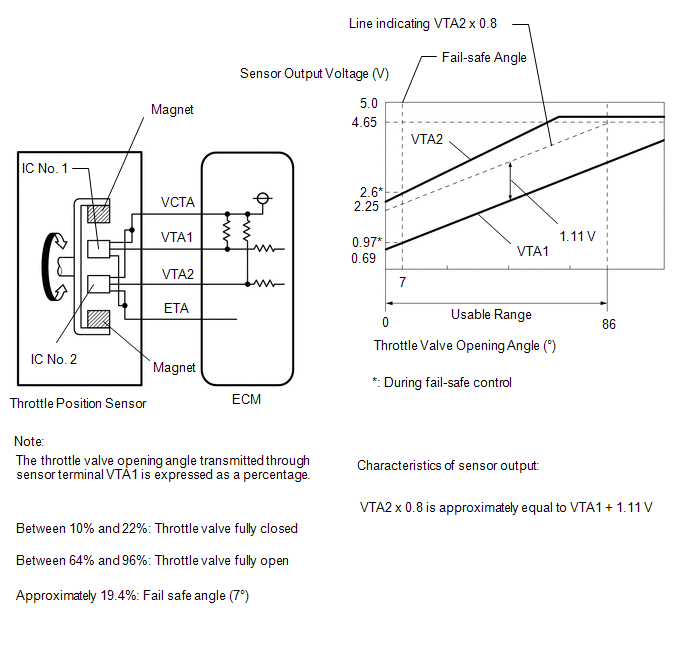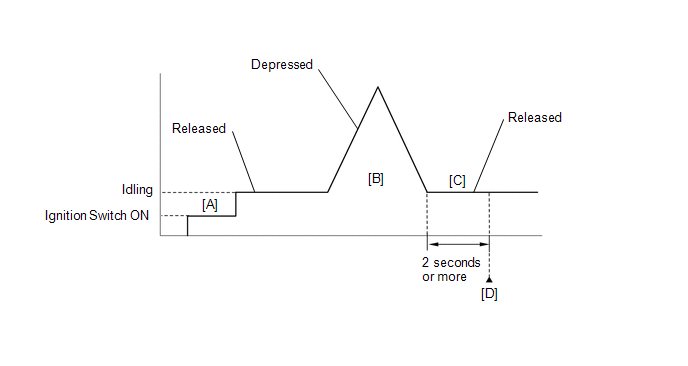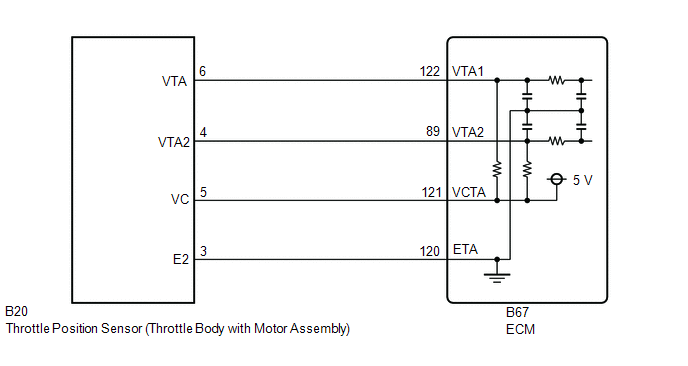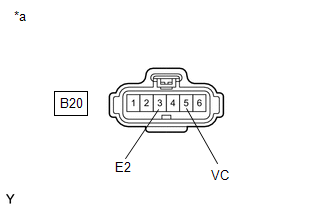- DTC judgment completed
- System normal
| Last Modified: 08-28-2024 | 6.11:8.1.0 | Doc ID: RM100000000YSPK |
| Model Year Start: 2017 | Model: Sienna | Prod Date Range: [08/2016 - 11/2017] |
| Title: 2GR-FKS (ENGINE CONTROL): SFI SYSTEM: P012011,P012015,P01201C,P022011,P022015,P21352B; Throttle / Pedal Position Sensor / Switch "A" Circuit Short to Ground; 2017 MY Sienna [08/2016 - 11/2017] | ||
|
DTC |
P012011 |
Throttle / Pedal Position Sensor / Switch "A" Circuit Short to Ground |
|
DTC |
P012015 |
Throttle / Pedal Position Sensor / Switch "A" Circuit Short to Battery or Open |
|
DTC |
P01201C |
Throttle / Pedal Position Sensor / Switch "A" Circuit Voltage Out of Range |
|
DTC |
P022011 |
Throttle/Pedal Position Sensor/Switch "B" Circuit Short to Ground |
|
DTC |
P022015 |
Throttle/Pedal Position Sensor/Switch "B" Circuit Short to Battery or Open |
|
DTC |
P21352B |
Throttle/Pedal Position Sensor/Switch "A"/"B" Voltage Correlation Signal Cross Coupled |
DESCRIPTION
HINT:
These DTCs relate to the throttle position sensor.
The throttle position sensor is mounted on the throttle body with motor assembly and detects the opening angle of the throttle valve. This sensor is a non-contact type sensor. It uses Hall-effect elements in order to yield accurate signals even in extreme driving conditions, such as at high speeds as well as very low speeds.
The throttle position sensor has 2 sensor circuits, VTA1 and VTA2 each of which transmits a signal. VTA1 is used to detect the throttle valve angle and VTA2 is used to detect malfunctions in VTA1. The sensor signal voltages vary between 0 V and 5 V in proportion to the throttle valve opening angle, and are transmitted to the VTA1 and VTA2 terminals of the ECM.
As the valve closes, the sensor output voltage decreases and as the valve opens, the sensor output voltage increases. The ECM calculates the throttle valve opening angle according to these signals and controls the throttle actuator in response to driver inputs. These signals are also used in calculations such as air fuel ratio correction, power increase correction and fuel-cut control.

|
DTC No. |
Detection Item |
DTC Detection Condition |
Trouble Area |
MIL |
Memory |
Note |
|---|---|---|---|---|---|---|
|
P012011 |
Throttle / Pedal Position Sensor / Switch "A" Circuit Short to Ground |
The output voltage of VTA1 is less than 0.56 V for 2 seconds or more (1 trip detection logic). |
|
Comes on |
DTC stored |
|
|
P012015 |
Throttle / Pedal Position Sensor / Switch "A" Circuit Short to Battery or Open |
The output voltage of VTA1 is higher than 4.535 V for 2 seconds or more (1 trip detection logic). |
|
Comes on |
DTC stored |
|
|
P01201C |
Throttle / Pedal Position Sensor / Switch "A" Circuit Voltage Out of Range |
The difference between the output voltage of VTA1 and VTA2 is less than 0.8 V, or higher than 1.6 V for 2 seconds or more (1 trip detection logic). |
|
Comes on |
DTC stored |
|
|
P022011 |
Throttle/Pedal Position Sensor/Switch "B" Circuit Short to Ground |
The output voltage of VTA2 is less than 2.05 V for 2 seconds or more (1 trip detection logic). |
|
Comes on |
DTC stored |
|
|
P022015 |
Throttle/Pedal Position Sensor/Switch "B" Circuit Short to Battery or Open |
The output voltage of VTA2 is higher than 4.75 V, and VTA1 is less than 2.367 V for 2 seconds or more (1 trip detection logic). |
|
Comes on |
DTC stored |
|
|
P21352B |
Throttle/Pedal Position Sensor/Switch "A"/"B" Voltage Correlation Signal Cross Coupled |
The difference between the output voltages of VTA1 and VTA2 is 0.02 V or less for 2 seconds or more (1 trip detection logic). |
|
Comes on |
DTC stored |
|
HINT:
- When any of these DTCs are output, check the throttle valve opening angle using the Techstream. Enter the following menus: Powertrain / Engine / Data List / Throttle Position Sensor No.1 Voltage and Throttle Position Sensor No.2 Voltage.
-
Throttle Position Sensor No.1 Voltage is the VTA1 signal, and Throttle Position Sensor No.2 Voltage is the VTA2 signal.
Reference (Normal Condition):
Techstream Display
Accelerator Pedal Fully Released
Accelerator Pedal Fully Depressed (Engine Running)
Throttle Position Sensor No.1 Voltage
0.6 to 1.1 V
3.2 to 4.8 V
Throttle Position Sensor No.2 Voltage
2.1 to 3.1 V
4.6 to 4.98 V
MONITOR DESCRIPTION
The ECM uses the throttle position sensor to monitor the throttle valve opening angle. There are several checks that the ECM performs to confirm the proper operation of the throttle position sensor.
P012011, P012015, P022011, P022015 and P21352B:
- A specific voltage difference is expected between the sensor terminals, VTA1 and VTA2, for each throttle valve opening angle. If the difference between VTA1 and VTA2 is incorrect, the ECM interprets this as a malfunction in the sensor circuit, and stores a DTC.
- VTA1 and VTA2 each have a specific voltage range. If VTA1 or VTA2 is outside the normal operating range, the ECM interprets this as a malfunction in the sensor circuit, and stores a DTC.
- VTA1 and VTA2 should never be close to the same voltage level. If VTA1 is within 0.02 V of VTA2, the ECM determines that there is a short circuit in the sensor circuit, and stores a DTC.
P01201C:
-
This sensor transmits two signals: VTA1 and VTA2. VTA1 is used to detect the throttle opening angle and VTA2 is used to detect malfunctions in VTA1. The ECM performs several checks to confirm the proper operation of the throttle position sensor and VTA1.
For each throttle opening angle, a specific voltage difference is expected between the outputs of VTA1 and VTA2. If the output voltage difference between the two signals deviates from the normal operating range, the ECM interprets this as a malfunction in the throttle position sensor. In this case the ECM will illuminate the MIL and store this DTC.
MONITOR STRATEGY
|
Related DTCs |
P0121: Throttle position sensor rationality P0122: Throttle position sensor 1 range check (low voltage) P0123: Throttle position sensor 1 range check (high voltage) P0222: Throttle position sensor 2 range check (low voltage) P0223: Throttle position sensor 2 range check (high voltage) P2135: Throttle position sensor range check (correlation) |
|
Required Sensors/Components (Main) |
Throttle position sensor |
|
Required Sensors/Components (Related) |
- |
|
Frequency of Operation |
Continuous |
|
Duration |
2 seconds: P0122, P0123, P0222, P0223 and P2135 Within 2 seconds: P0121 |
|
MIL Operation |
Immediate |
|
Sequence of Operation |
None |
TYPICAL ENABLING CONDITIONS
All
|
Monitor runs whenever the following DTCs are not stored |
None |
P0122, P0123, P0222, P0223 and P2135
|
All of the following conditions are met |
- |
|
Battery voltage |
8 V or higher |
|
Ignition switch |
ON |
|
Starter |
Off |
P0121
|
Either of the following conditions is met |
A or B |
|
A. Ignition switch |
ON |
|
B. Throttle actuator power |
On |
|
Throttle position sensor circuit fail (P0122, P0123, P0222, P0223, P2135) |
Not detected |
TYPICAL MALFUNCTION THRESHOLDS
P0121
|
Either of the following conditions is met |
A or B |
|
A. Difference of learned throttle position sensor opener position voltage between VTA2 and VTA1 |
Higher than 1.6 V |
|
B. Difference of learned throttle position sensor opener position voltage between VTA2 and VTA1 |
Less than 0.8 V |
P0122
|
VTA1 voltage |
Less than 0.56 V |
P0123
|
VTA1 voltage |
Higher than 4.535 V |
P0222
|
VTA2 voltage |
Less than 2.05 V |
P0223
|
VTA2 voltage when VTA1 less than 2.367 V |
Higher than 4.75 V |
P2135
|
Difference between VTA1 and VTA2 voltages |
0.02 V or less |
CONFIRMATION DRIVING PATTERN
HINT:

- Connect the Techstream to the DLC3.
- Turn the ignition switch to ON and turn the Techstream on.
- Clear the DTCs (even if no DTCs are stored, perform the clear DTC procedure).
- Turn the ignition switch off and wait for at least 30 seconds.
- Turn the ignition switch to ON and turn the Techstream on [A].
- Start the engine.
- With the vehicle stationary, fully depress and release the accelerator pedal [B].
- Idle the engine for 2 seconds or more [C].
- Enter the following menus: Powertrain / Engine / Trouble Codes [D].
-
Read the pending DTCs.
HINT:
- If a pending DTC is output, the system is malfunctioning.
- If a pending DTC is not output, perform the following procedure.
- Enter the following menus: Powertrain / Engine / Utility / All Readiness.
- Input the DTC: P012011, P012015, P01201C, P022011, P022015 or P21352B.
-
Check the DTC judgment result.
Techstream Display
Description
NORMAL
ABNORMAL
- DTC judgment completed
- System abnormal
INCOMPLETE
- DTC judgment not completed
- Perform driving pattern after confirming DTC enabling conditions
HINT:
- If the judgment result shows NORMAL, the system is normal.
- If the judgment result shows ABNORMAL, the system has a malfunction.
- If the judgment result shows INCOMPLETE, perform steps [B] through [D] again.
-
[A] to [D]: Normal judgment procedure.
The normal judgment procedure is used to complete DTC judgment and also used when clearing permanent DTCs.
- When clearing the permanent DTCs, do not disconnect the cable from the battery terminal or attempt to clear the DTCs during this procedure, as doing so will clear the universal trip and normal judgment histories.
FAIL-SAFE
When any of these DTCs or other DTCs relating to Electronic Throttle Control System (ETCS) malfunctions are stored, the ECM enters fail-safe mode. During fail-safe mode, the ECM cuts the current to the throttle actuator, and the throttle valve is returned to a 7° throttle valve opening angle by the return spring. The ECM then adjusts the engine output by controlling the fuel injection (intermittent fuel-cut) and ignition timing, in accordance with the accelerator pedal angle, to allow the vehicle to continue running at a minimal speed. If the accelerator pedal is depressed firmly and gently, the vehicle can be driven slowly.
Fail-safe mode continues until a pass condition is detected, and the ignition switch is then turned off.
WIRING DIAGRAM

CAUTION / NOTICE / HINT
HINT:
Read freeze frame data using the Techstream. The ECM records vehicle and driving condition information as freeze frame data the moment a DTC is stored. When troubleshooting, freeze frame data can help determine if the vehicle was moving or stationary, if the engine was warmed up or not, if the air fuel ratio was lean or rich, and other data from the time the malfunction occurred.
PROCEDURE
|
1. |
READ VALUE USING TECHSTREAM (THROTTLE POSITION SENSOR) |
(a) Connect the Techstream to the DLC3.
(b) Start the engine.
(c) Turn the Techstream on.
(d) Enter the following menus: Powertrain / Engine / Data List / Throttle Position Sensor No.1 Voltage and Throttle Position Sensor No.2 Voltage.
(e) Read the values displayed on the Techstream.
|
When Accelerator Pedal Fully Released |
When Accelerator Pedal Fully Depressed (Engine Running) |
Trouble Area |
Proceed to |
||
|---|---|---|---|---|---|
|
Throttle Position Sensor No.1 Voltage (VTA1) |
Throttle Position Sensor No.2 Voltage (VTA2) |
Throttle Position Sensor No.1 Voltage (VTA1) |
Throttle Position Sensor No.2 Voltage (VTA2) |
||
|
0 to 0.2 V |
0 to 0.2 V |
0 to 0.2 V |
0 to 0.2 V |
VCTA circuit open |
A |
|
4.5 to 4.98 V |
4.5 to 4.98 V |
4.5 to 4.98 V |
4.5 to 4.98 V |
ETA circuit open |
|
|
0 to 0.2 V, or 4.5 to 4.98 V |
2.1 to 3.1 V (Fail-safe) |
0 to 0.2 V, or 4.5 to 4.98 V |
2.1 to 3.1 V (Fail-safe) |
VTA1 circuit open or ground short |
|
|
0.6 to 1.4 V (Fail-safe) |
0 to 0.2 V, or 4.5 to 4.98 V |
0.6 to 1.4 V (Fail-safe) |
0 to 0.2 V, or 4.5 to 4.98 V |
VTA2 circuit open or ground short |
|
|
0.6 to 1.1 V |
2.1 to 3.1 V |
3.2 to 4.8 V (Not fail-safe) |
4.6 to 4.98 V (Not fail-safe) |
Throttle position sensor circuit normal |
B |
HINT:
-
DTC P01201C is stored when the VTA1 and VTA2 output voltages are not consistent with the sensor characteristics. Therefore, check the freeze frame data when this DTC is stored. Use the following formula to confirm the relative differences in voltage.
Characteristic Sensor Output:
VTA2 x 0.8 is approximately equal to VTA1 + 1.11 V
VTA1: Throttle Position Sensor No.1 Voltage
VTA2: Throttle Position Sensor No.2 Voltage
- If DTC P01201C is output, proceed to "Check Harness And Connector (Throttle Position Sensor - ECM)".
| B |

|
|
|
2. |
CHECK HARNESS AND CONNECTOR (THROTTLE POSITION SENSOR - ECM) |
(a) Disconnect the B20 throttle body with motor assembly connector.
(b) Disconnect the B67 ECM connector.
(c) Measure the resistance according to the value(s) in the table below.
Standard Resistance:
|
Tester Connection |
Condition |
Specified Condition |
|---|---|---|
|
B20-5 (VC) - B67-121 (VCTA) |
Always |
Below 1 Ω |
|
B20-6 (VTA) - B67-122 (VTA1) |
Always |
Below 1 Ω |
|
B20-4 (VTA2) - B67-89 (VTA2) |
Always |
Below 1 Ω |
|
B20-3 (E2) - B67-120 (ETA) |
Always |
Below 1 Ω |
|
B20-5 (VC) or B67-121 (VCTA) - Body ground and other terminals |
Always |
10 kΩ or higher |
|
B20-6 (VTA) or B67-122 (VTA1) - Body ground and other terminals |
Always |
10 kΩ or higher |
|
B20-4 (VTA2) or B67-89 (VTA2) - Body ground and other terminals |
Always |
10 kΩ or higher |
| NG |

|
REPAIR OR REPLACE HARNESS OR CONNECTOR |
|
|
3. |
INSPECT ECM (VC VOLTAGE) |

|
*a |
Front view of wire harness connector (to Throttle Body with Motor Assembly) |
(a) Disconnect the throttle body with motor assembly connector.
(b) Turn the ignition switch to ON.
(c) Measure the voltage according to the value(s) in the table below.
Standard Voltage:
|
Tester Connection |
Switch Condition |
Specified Condition |
|---|---|---|
|
B20-5 (VC) - B20-3 (E2) |
Ignition switch ON |
4.5 to 5.5 V |
| NG |

|
|
|
4. |
REPLACE THROTTLE BODY WITH MOTOR ASSEMBLY |
(a) Replace the throttle body with motor assembly.
HINT:
Perform "Inspection After Repair" after replacing the throttle body with motor assembly.
|
|
5. |
CHECK WHETHER DTC OUTPUT RECURS (THROTTLE POSITION SENSOR DTCS) |
(a) Connect the Techstream to the DLC3.
(b) Turn the ignition switch to ON.
(c) Turn the Techstream on.
(d) Clear the DTCs.
(e) Turn the ignition switch off and wait for at least 30 seconds.
(f) Turn the ignition switch to ON.
(g) Turn the Techstream on.
(h) Drive the vehicle in accordance with the driving pattern described in Confirmation Driving Pattern.
(i) Enter the following menus: Powertrain / Engine / Trouble Codes.
(j) Read the DTCs.
|
Result |
Proceed to |
|---|---|
|
DTC P012011, P012015, P01201C, P022011, P022015 and/or P21352B are output |
A |
|
DTCs are not output |
B |
| A |

|
| B |

|
END |
|
|
|
![2017 - 2020 MY Sienna [08/2016 - ]; 2GR-FKS (ENGINE CONTROL): SFI SYSTEM: DTC CHECK / CLEAR](/t3Portal/stylegraphics/info.gif)
